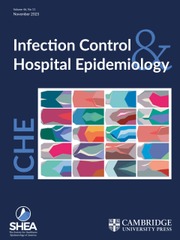Crossref Citations
This article has been cited by the following publications. This list is generated based on data provided by
Crossref.
Hyle, Emily P.
Gasink, Leanne B.
Linkin, Darren R.
Bilker, Warren B.
and
Lautenbach, Ebbing
2007.
Use of different thresholds of prior antimicrobial use in defining exposure: Impact on the association between antimicrobial use and antimicrobial resistance.
Journal of Infection,
Vol. 55,
Issue. 5,
p.
414.
Lautenbach, Ebbing
2007.
Antimicrobial Resistance: Problem Pathogens and Clinical Countermeasures.
p.
61.
Tacconelli, Evelina
and
Cataldo, Maria A.
2009.
Identifying Risk Factors for Infections: The Role of Meta-analyses.
Infectious Disease Clinics of North America,
Vol. 23,
Issue. 2,
p.
211.
Curcio, Daniel
Barcelona, Laura I.
Cornistein, Wanda
Bantar, Carlos
Barcan, Laura
Bonvehí, Pablo
Reina, Rosa
Bergallo, Carlos
Biondi, Héctor
Calderón, Jorge
Castagnino, Jorge
Chinchilla, Paulo
Dignani, María Cecilia
Esposto, Amadeo
Pérez, Norma Falcón
Freuler, Cristina
Luna, Carlos M.
Ríos, Fernando
Rodriguez, Claudia
valentini, Ricardo
Vazquez, Walter
verbanaz, Sergio
and
vergara, Gabriel
2009.
Current Rational to Prescribe Tigecycline: Critical Analysis of the Evidence and Usage Algorithms by an Argentinean Experts Panel.
Clinical Medicine. Therapeutics,
Vol. 1,
Issue. ,
Tacconelli, Evelina
2009.
Antimicrobial use: risk driver of multidrug resistant microorganisms in healthcare settings.
Current Opinion in Infectious Diseases,
Vol. 22,
Issue. 4,
p.
352.
Hyle, E. P.
Ferraro, M. J.
Silver, M.
Lee, H.
and
Hooper, D. C.
2010.
Ertapenem-Resistant Enterobacteriaceae Risk Factors for Acquisition and Outcomes.
Infection Control & Hospital Epidemiology,
Vol. 31,
Issue. 12,
p.
1242.
Bader, Mazen S.
and
Hawboldt, John
2010.
Antibiotic Prescribing and Antimicrobial Resistance.
Postgraduate Medicine,
Vol. 122,
Issue. 4,
p.
227.
Woeltje, Keith F.
and
Lautenbach, Ebbing
2011.
Informatics and Epidemiology in Infection Control.
Infectious Disease Clinics of North America,
Vol. 25,
Issue. 1,
p.
261.
Francisco Tuon, Felipe
Kruger, Margot
Terreri, Marcos
Penteado-Filho, Sergio R.
and
Gortz, Lucas
2011.
Klebsiella ESBL bacteremia-mortality and risk factors.
The Brazilian Journal of Infectious Diseases,
Vol. 15,
Issue. 6,
p.
594.
Kritsotakis, E. I.
Tsioutis, C.
Roumbelaki, M.
Christidou, A.
and
Gikas, A.
2011.
Antibiotic use and the risk of carbapenem-resistant extended-spectrum- -lactamase-producing Klebsiella pneumoniae infection in hospitalized patients: results of a double case-control study.
Journal of Antimicrobial Chemotherapy,
Vol. 66,
Issue. 6,
p.
1383.
De Angelis, Giulia
Restuccia, Giovanni
Venturiello, Silvia
Cauda, Roberto
Malhotra-Kumar, Surbhi
Goossens, Herman
Schrenzel, Jacques
and
Tacconelli, Evelina
2012.
Nosocomial acquisition of methicillin-resistant Staphyloccocus aureus (MRSA) and extended-spectrum beta-lactamase (ESBL) Enterobacteriaceae in hospitalised patients: a prospective multicenter study.
BMC Infectious Diseases,
Vol. 12,
Issue. 1,
Thiebaut, A. C. M.
Arlet, G.
Andremont, A.
Papy, E.
Sollet, J.-P.
Bernede-Bauduin, C.
Guillemot, D.
and
Schlemmer, B.
2012.
Variability of intestinal colonization with third-generation cephalosporin-resistant Enterobacteriaceae and antibiotic use in intensive care units.
Journal of Antimicrobial Chemotherapy,
Vol. 67,
Issue. 6,
p.
1525.
Linkin, Darren R.
and
Lautenbach, Ebbing
2012.
Pharmacoepidemiology.
p.
827.
Kim, Si-Hyun
Kwon, Jae-Cheol
Choi, Su-Mi
Lee, Dong-Gun
Park, Sun Hee
Choi, Jung-Hyun
Yoo, Jin-Hong
Cho, Byung-Sik
Eom, Ki-Seong
Kim, Yoo-Jin
Kim, Hee-Je
Lee, Seok
Min, Chang-Ki
Cho, Seok-Goo
Kim, Dong-Wook
Lee, Jong-Wook
and
Min, Woo-Sung
2013.
Escherichia coli and Klebsiella pneumoniae bacteremia in patients with neutropenic fever: factors associated with extended-spectrum β-lactamase production and its impact on outcome.
Annals of Hematology,
Vol. 92,
Issue. 4,
p.
533.
Schechner, Vered
Temkin, Elizabeth
Harbarth, Stephan
Carmeli, Yehuda
and
Schwaber, Mitchell J.
2013.
Epidemiological Interpretation of Studies Examining the Effect of Antibiotic Usage on Resistance.
Clinical Microbiology Reviews,
Vol. 26,
Issue. 2,
p.
289.
Han, Jennifer H.
Bilker, Warren B.
Nachamkin, Irving
Tolomeo, Pam
Mao, Xiangqun
Fishman, Neil O.
and
Lautenbach, Ebbing
2013.
Impact of Antibiotic Use during Hospitalization on the Development of Gastrointestinal Colonization with Escherichia coli with Reduced Fluoroquinolone Susceptibility.
Infection Control & Hospital Epidemiology,
Vol. 34,
Issue. 10,
p.
1070.
Plankar Srovin, Tina
Seme, Katja
Blagus, Rok
Tomazin, Rok
and
Čižman, Milan
2014.
Risk factors for colonization with ampicillin and high-level aminoglycoside-resistant enterococci during hospitalization in the ICU and the impact of prior antimicrobial exposure definition: a prospective cohort study.
Journal of Chemotherapy,
Vol. 26,
Issue. 1,
p.
19.
Averbuch, Diana
and
Engelhard, Dan
2016.
Transplant Infections.
p.
357.
Coppry, M
Jeanne-Leroyer, C
Noize, P
Dumartin, C
Boyer, A
Bertrand, X
Dubois, V
and
Rogues, A -M
2019.
Antibiotics associated with acquisition of carbapenem-resistantPseudomonas aeruginosain ICUs: a multicentre nested case–case–control study.
Journal of Antimicrobial Chemotherapy,
Vol. 74,
Issue. 2,
p.
503.
Tacconelli, E.
Górska, A.
De Angelis, G.
Lammens, C.
Restuccia, G.
Schrenzel, J.
Huson, D.H.
Carević, B.
Preoţescu, L.
Carmeli, Y.
Kazma, M.
Spanu, T.
Carrara, E.
Malhotra-Kumar, S.
and
Gladstone, B.P.
2020.
Estimating the association between antibiotic exposure and colonization with extended-spectrum β-lactamase-producing Gram-negative bacteria using machine learning methods: a multicentre, prospective cohort study.
Clinical Microbiology and Infection,
Vol. 26,
Issue. 1,
p.
87.

